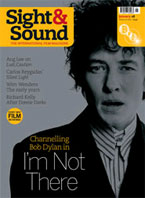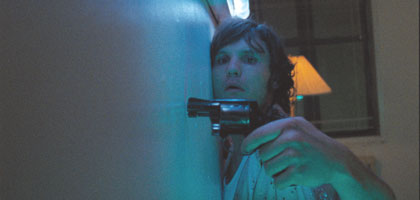Primary navigation

UK 2007

Reviewed by Mark Fisher
Our synopses give away the plot in full, including surprise twists.
While working in Hawaii as a security guard, Mark Chapman happens upon a copy of Catcher in the Rye in a local library, and becomes obsessed with its hero, Holden Caulfield. After reading a book about John Lennon, Chapman becomes fixated on the singer. The contrast between Lennon's vast private wealth and his public calls to abandon all possessions make him, in Chapman's mind, the ultimate 'phoney'. Determined to kill Lennon, Chapman buys a gun and a one-way ticket to New York, where he eventually shoots the singer. After Chapman is arrested and imprisoned, he comes to believe that the killing happened to raise awareness of Catcher in the Rye, and will speak only about the book. He changes his plea to guilty, and is sentenced to 20 years in jail. Imprisoned in Attica, Chapman fears that he will be killed. He starts talking in tongues and is the subject of an exorcism. The film ends with a shot of Chapman standing naked to the waist, with a finger pointed at his head as if it were a gun.
The Killing of John Lennon begins by informing us that the words of the voiceover belong to Lennon's assassin, Mark Chapman. It quickly becomes clear, however, that many of the words do not originate with Chapman at all, but with Paul Schrader. "Loneliness has followed me my whole life," Chapman recites. "All my life needed was a sense of someplace to go." These are only two of many unattributed references in The Killing of John Lennon to Schrader's Taxi Driver script. J.D. Salinger's The Catcher in the Rye is the 'official' object of Chapman's obsession, the document that ostensibly catalyses his homicidal project. Yet it is evident from the voiceover (all the words of which are indeed taken from Chapman's journals) that Taxi Driver was at least as important as Salinger's novel in shaping Chapman's psychopathology.
But while the Chapman character, played by Jonas Ball, is evangelical about Catcher in the Rye, Taxi Driver is never mentioned by name (the closest that The Killing of John Lennon comes to explicitly acknowledging Scorsese's film is Chapman's observation that "Travis was right, one day a real rain will come"). When Chapman arrives in New York, he does watch a Scorsese film, but it is Raging Bull, not Taxi Driver. It as if the encounter with Taxi Driver is too traumatic for either Chapman or the film to acknowledge directly.
Officially, The Killing of John Lennon is a claustrophobic view of the mind of Lennon's assassin from the inside: we follow the misfit Chapman from his home in Hawaii to New York, where he famously kills Lennon outside the Dakota building. In the end, though, the film works best as an analysis of assassination as plagiarism. Chapman appears as a kind of bad but spectacularly successful postmodern author, synthesising his influences not into an act of artistic production, but murder, acting out in the (hyper) real what had previously only happened on the page and on the screen. Chapman becomes Travis (whose name was itself a cinematic reference, to Mick Travis in If...), stalking a New York transformed by Bickle's misanthropy and misguided sense of mission into a sin city that can only be redeemed by a symbolic act of murder. Chapman declares that he didn't only kill Lennon, he ended an era, the 1960s. Yet Chapman's killing of the star can be seen as in many ways an attempt to revive the perverse montage of murder and megastardom that defined the 1960s. In J.G. Ballard's definitive examination of 1960s mediatised violence, The Atrocity Exhibition, the lead character (saturated in cinema and TV, and sometimes referred to as 'Travis') "wants to kill Kennedy again, but this time in a way that makes sense." Chapman's would-be redemptive act belongs to the same (patho) logic of ritualised violence inspired by, and taking place in, the media landscape. (Even the Dakota building is a cinema reference: Rosemary's Baby was filmed there.) When, in jail, Chapman sees a news report about John Hinckley, who attempted to kill former film star Ronald Reagan and was obsessed with Jodie Foster and Taxi Driver , he complains that he has been plagiarised.
Meticulously - one could almost say forensically - researched, and filmed in the locations where the actual events occurred, The Killing of John Lennon often seems more like a reconstruction than a feature film. Rather like Chapman, director Andrew Piddington is unable to transcend his influences. He cannot mythologise, as Salinger, Scorsese and Schrader did, he can only re-cite and re-stage. What could have been an analysis of the dead end of postmodernity becomes one more postmodern artefact. The techniques used - long-lens slow-motion shots contrasted with rapid editing - are over-familiar cinematic signifiers of psychosis. But, despite the audience being immersed almost entirely in Chapman's point of view, we feel strangely distanced from him. We are not forced into the uncomfortable identification that Taxi Driver caused the audience to feel for Travis Bickle, nor are we capable of feeling any moral disgust. We remain detached spectators, increasingly disconnected as the film continues (it feels at least half an hour too long). When Chapman is in a New York movie theatre, we are shown long sections of both Raging Bull and Ordinary People over his shoulder. This is the position in which the audience is placed in relation to Chapman: we are consumers of reiterating images, trapped in a hall of cinematic mirrors, passive spectators of a man who, entranced and colonised by the TV/cinema spectacle, committed an act that was designed to be consumed by the same spectacle.